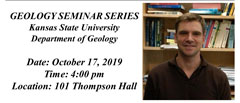October 14, 2019
Reminder: Ocean Discovery distinguished speaker will present on slope failure and tsunami hazards

The geology department will host Matt Hornbach, 2109 Ocean Discovery distinguished speaker, at 4 p.m. Thursday, Oct. 17, in 101 Thompson Hall.
Hornbach is a professor of geophysics in the department of earth sciences at Southern Methodist University. Before joining SMU in 2010, Hornbach was a research associate at the University of Texas at Austin, Institute for Geophysics, where he also completed a two-year postdoc. He obtained his doctorate in geophysics from the University of Wyoming in 2004 and his undergraduate degree in physics at Hamilton College in 1998.
For more than 20 years, the Ocean Discovery Lecture Series — formerly the Distinguished Lecturer Series — has brought the remarkable scientific results and discoveries of the International Ocean Discovery Program and its predecessor programs to academic research institutions, museums and aquaria. Since 1991, more than 1,000 presentations to diverse audiences have been made through the lecture series. This is the second consecutive year that K-State geology is hosting an ocean discovery distinguished speaker.
Students will receive K-State 360 problem-solving competency points with GPS check-in at this event.
Students enrolled in GEOL 125 section A and C (11523, 14357) will receive extra credit for attending and writing an overview of the talk.
Abstract:
How common are slide-generated tsunamis? Historical analysis of tsunami catalogs suggests only 3-9% of all reported tsunamis are generated via submarine landslides or volcanic eruptions. As a result, slide-generate tsunamis are often considered a low-risk geohazard. But is this really true? The Dec. 22, 2018, Sumatra tsunami generated by sector collapse of Anak Krakatau highlights the importance of understanding these geologic phenomena. This presentation begins with a basic primer on landslide tsunami generation and outlines how they differ in character and dynamics from classic earthquake tsunamis. We then discuss three landslide-tsunami case studies that integrate International Ocean Discovery Program research and datasets. These case studies demonstrate how submarine slides have historically played a more important role in tsunami generation in the Pacific, Caribbean, and North Atlantic than we often realize. The analysis concludes by showing that in some geologic settings, the risk of slide-generated tsunamis is far greater than traditional studies suggest, with regional sedimentation patterns and sediment physical properties likely playing a more important role than tectonics in defining the tsunami hazard.
